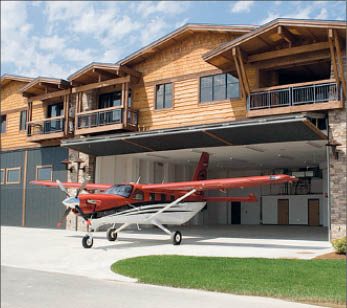
Home » Sandpoint fly-in community throttles up
Sandpoint fly-in community throttles up
After years of contention, FAA directed to allow runway access easements

July 5, 2012
The long-planned, $26 million-plus SilverWing at Sandpoint fly-in community once again is revving up its marketing now that access to the runway at Sandpoint, Idaho, is free of federal red tape, clearing the development for takeoff, says Michael Mileski, who's involved in the development.
The federal reauthorization act that funds the Federal Aviation Administration contains language that directs the agency to accommodate existing easement and access agreements between public airports and fly-in airpark communities, including such an agreement involving SilverWing, Mileski says.
The 18-acre, 44-lot SilverWing development is located at the north edge of the city of Sandpoint, just west of the southern portion of the 5,500-foot-long main runway at the Sandpoint Airport, about 75 miles northeast of Spokane.
The gated community sits roughly midway between Lake Pend Oreille and Schweitzer Mountain Resort, and is a short drive from downtown Sandpoint, says Mileski, who heads up SilverWing at Sandpoint LLC along with fellow California businessman John McKeown.
"In our marketing, we're really selling the city of Sandpoint," Mileski says. "We picked the spot because Sandpoint is a great town with year-round activities."
SilverWing had been approved by the city of Sandpoint and Bonner County in 2007, but the development essentially has been grounded since then due to objections by the FAA about having a residential development alongside a public airport. The FAA had withheld federal funding for the Sandpoint Airport starting in 2008, alleging that Bonner County, which operates the facility, didn't have federal approval to enter an access agreement that granted SilverWing a perpetual easement allowing access between the development and the runway.
With the easement no longer in question, the development is in line for takeoff, Mileski says.
Marketing efforts will target air shows, fly-in events, and aviation media, he says.
SilverWing has installed infrastructure for the development including a taxiway.
Last year, it completed a two-story model home, which has 2,100 square feet of living space on the second floor and 2,100 square feet of hangar space on the ground floor. It has also sold two other lots and a similar sized building shell with an unfinished interior adjacent to the model home.
Contractors Northwest Inc., of Coeur d'Alene, built the model home and adjacent structure, and Miller Stauffer Architects PA, also of Coeur d'Alene, designed them.
The remaining lots range in price from $95,000 to $1.7 million and in size from 6,300 square feet to 26,800 square feet.
Buyers will own the land, and they can select from five SilverWing floor plans, which range from 4,200 to 8,500 square feet of combined living and hangar space. They also can build to their own specifications, subject to approval by SilverWing's design committee, Mileski says.
Fly-in homes to be built there likely will cost more than $500,000 each, he says. Some will cost substantially more than that. The model home, for instance, is listed at $1.8 million, and the adjacent structure has sold for $1.3 million.
"You could just put up a hangar, but it would defeat the purpose," Mileski, says. "It's designed and approved for residential use."
Factoring the minimum lot prices and home-hangar costs estimates, the total value of the development would be more than $26 million.
SilverWing also is the fixed-base operator (FBO) for the airport and provides fuel, maintenance, and tie-down services. The FBO also offers flight training, tours, and charter flights with two single-engine Cessna airplanes. It has three full-time employees and hires up to three additional part-time employees during the peak summer season, Mileski says.
As SilverWing climbs further off the ground, the developers plan to construct a recreational center with a swimming pool, spa area, and outdoor kitchen within the development, he says.
Mileski claims the SilverWing development will provide some of the last opportunities for aviation enthusiasts to own a fly-in residence at a county-run airport. The same legislation that lifts the FAA sanctions for existing access agreements makes it difficult for developers to establish new fly-in communities at public facilities, he says.
"You don't find a lot of residential developments on public airports," Mileski says.
Latest News
Related Articles





_web.jpg?1729753270)